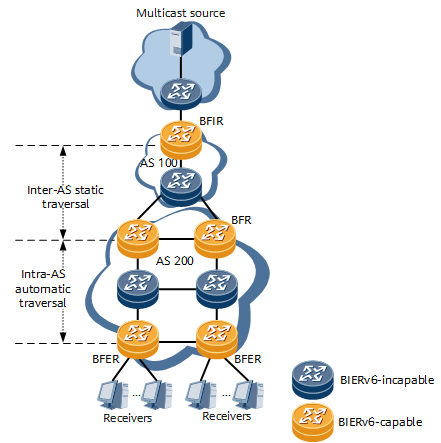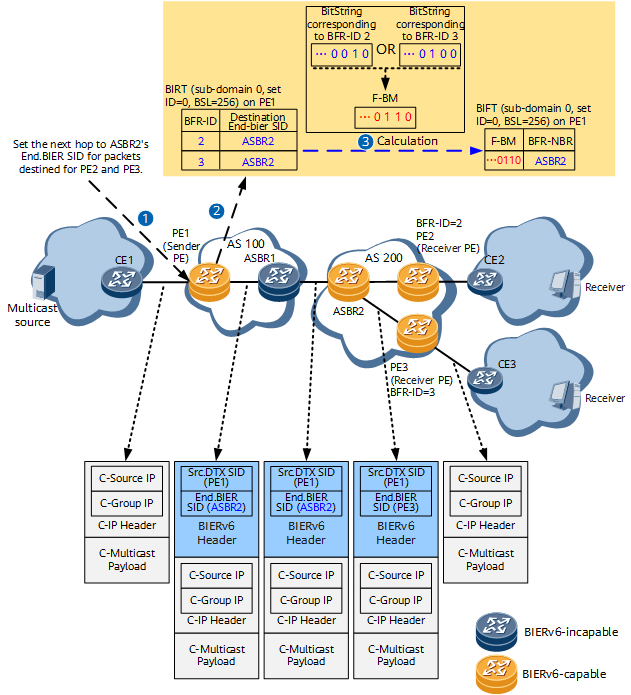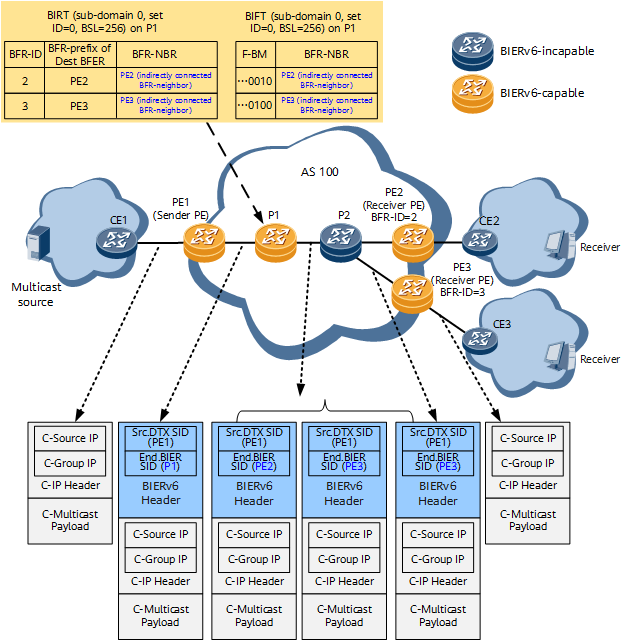BIERv6 Inter-AS Static Traversal and Intra-AS Automatic Traversal
Overview of BIERv6 Traversal
BIERv6 is a next-generation multicast protocol, meaning that some nodes on the live network may not yet support it. If BIERv6-capable and BIERv6-incapable nodes coexist, inter-AS static traversal or intra-AS automatic traversal is required to allow BIERv6 multicast packets to traverse the BIERv6-incapable nodes as native IPv6 packets. Figure 1 shows the networking.
Inter-AS Static Traversal
If some BIERv6-incapable nodes exist on an inter-AS BIERv6 network, these nodes cannot generate forwarding entries through the underlay. In this case, a BIERv6 next-hop neighbor needs to be manually set for the upstream node of each BIERv6-incapable node. Currently, the End.BIER SID of a BIERv6-capable next hop can be set for a specific range of BFR-IDs corresponding to the destination nodes of multicast packets.
Figure 2 shows the forwarding process, in which ASBR1 is BIERv6-incapable, and both its upstream node (PE1) and downstream node (ASBR2) are BIERv6-capable. This example assumes that BFIR-to-BFER is the downstream direction.
The process for BIERv6 packets to traverse ASBR1 is described as follows:
- PE1 must have ASBR2's End.BIER SID manually set as the next hop for the multicast packets destined for PE2 (with BFR-ID 2) and PE3 (with BFR-ID 3).
- PE1 generates a static BIRT based on the preceding configuration. The static BIRT contains only the BFR-IDs and the specified next-hop End.BIER SID, without BFR-prefixes.
- PE1 generates a BIFT based on the static BIRT according to the standard BIERv6 BIFT generation process.
- Because the BFR-neighbor in the BIFT is ASBR2, PE1 encapsulates the End.BIER SID of ASBR2 as the destination address of packet copies and forwards these copies based on the BitString and BIFT according to the standard BIERv6 forwarding process.
- After receiving the packet copies, ASBR1 reads their destination address and forwards them to ASBR2 according to the native IPv6 forwarding process.
Intra-AS Automatic Traversal
If some BIERv6-incapable nodes exist on a single-AS BIERv6 network, the BIERv6-capable nodes can generate forwarding entries through the underlay. Multicast packets can automatically traverse the BIERv6-incapable nodes as native IPv6 packets, requiring no additional configurations.
Figure 3 shows the forwarding process, in which P2 is BIERv6-incapable, and its upstream node (P1) is BIERv6-capable. This example assumes that BFIR-to-BFER is the downstream direction.
The process for BIERv6 packets to traverse P2 is described as follows:
- P1 and all other BIERv6-capable nodes generate their BIRTs by flooding packets with the TLVs defined in IS-ISv6 for BIERv6. The next hop from P1 to the node with BFR-ID 2 (PE2) is P2. Because P2 is BIERv6-incapable, P1 converts the BFR-neighbor to PE2 into the indirectly connected BFR-neighbor PE2 (destination node). Similarly, P1 converts the BFR-neighbor to PE3 into the indirectly connected BFR-neighbor PE3.
- P1 generates a BIFT based on the BIRT according to the standard BIERv6 BIFT generation process.
- Because the BFR-neighbors (PE2 and PE3) in the BIFT are indirectly connected to P1, P1 encapsulates the End.BIER SID of PE2 or PE3 as the destination address of each packet copy based on the BIFT. P1 then forwards the packet copies based on the BitString and BIFT according to the standard BIERv6 forwarding process.
- After receiving the two packet copies, P2 reads their destination addresses and forwards them according to the native IPv6 forwarding process: one copy to PE2, and the other to PE3.


